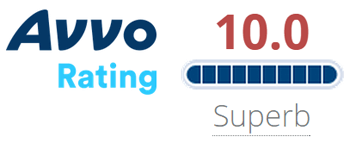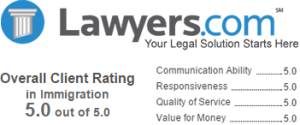UNCLASSIFIED TELEGRAM January 30, 2001 To: ALL DIPLOMATIC AND CONSULAR POSTS - PRIORITY Origin: VO From: SECSTATE WASHDC (STATE 17318 - PRIORITY) TAGS: CVIS, CMGT Captions: VISAS Subject: Processing V and K3 Visas: The View So Far Ref: State 00-242292 _________________________________________________________________Client Reviews

Legal Guru in All Things Immigration
“Mr. Shusterman and his law firm have represented my family and me very successfully. He is not only a legal guru in all things immigration but even more so he is an exceptional human being because he empathizes with his clients and cares that justice is done.”
- Maria Davari Knapp, Chicago, Illinois
Read More Reviews1. Summary. On December 21, 2000, The President signed into law a major immigration legislative package called the Legal Immigration and Family Equity (LIFE) Act and amendments. The LIFE Act creates new categories of NIVs to benefit certain second preference beneficiaries (V visas), as well as spouses of U.S. citizens (KII visas, to be issued as K3 visas). Pending further discussions with Congress and INS, the Department intends to process applicants for these new NIVs in a manner similar to that currently followed for K1 fiance visa applicants. This cable is intended to inform posts of the Department's current thinking on the implementation of the LIFE Act provisions. No specific action is required by conoffs at this time. No posts may begin issuing these new NIVs until instructed to do so by the Department by septel. However, posts should begin planning how to incorporate V and Kii visas into their workflow in accordance with the following general guidelines. End summary. V Visas ------- 2. To be eligible for the new V visa, a petition for the applicant must have been filed with INS for second preference status as the spouse of a legal permanent resident under Section 203(a)(2)(A) on or before the enactment of the LIFE Act on December 22, 2000. In addition, the applicant must demonstrate that since the filing of the petition, he/she has been waiting at least three years for 1) action by INS on the submitted petition, or 2) if the petition has been approved by INS, availability of a visa number under the worldwide numerical limitations, or 3) if a number is available, the application for adjustment of status or an immigrant visa remains pending. 3. For purposes of V visa processing, a visa application remains pending if the consular officer processing the visa does not offer the applicant an appointment date to make an application within 60 days of determining that the beneficiary has the necessary documents to begin the visa application process. This determination is usually made when the applicant returns the Packet three forms to signal that all required documents are in his/her possession. However, the manner of making this determination may vary among posts as some posts with high incidences of fraud or misreporting by applicants of documentary readiness may take extra steps to insure that the applicant does in fact have in their possession all the required documents. 4. An unmarried child of a V1 applicant may be issued a derivative V2 visa provided he/she is able to demonstrate that he/she is the child of a principal alien entitled to V1 classification. As V is an NIV classification and is not intended to be the final legal status of the applicant in the United States, issuance to V2 derivatives may precede issuance to the V1 principal applicant, in the same manner that IR2 status is not dependent on issuance to the IR1 beneficiary. V2 status is thus not relegated to accompanying or following to join the principal applicant. 5. V visa status is intended to permit long-separated families to reunite in the United States and together await availability of a visa number. Because V status is available only to those whose petitions were filed on or before December 21, 2000, this category effectively sunsets in three years or when the pool of eligible applicants eventually dissipates with V issuances over time. Unless extended by Congress, it is not a permanent addition to the list of visa classifications. 6. At this time, the intent is to process an applicant as an immigrant visa case if the priority date is current. Those with current priority dates will not rpt not be able to elect to apply instead for a V visa. The Department will make this clear to the public in an appropriate regulation. K3 Visas -------- 7. The LIFE Act expands the criteria for "K" visas beyond status for fiances of U.S. citizens. Under LIFE, a new K3 status is created for spouses of U.S. citizens. According to a joint memorandum from the Senate Subcommittee on Immigration, the K3 visa is not intended to be a prerequisite for the admission of U.S.citizens' spouses. It is meant to be a speedy mechanism for the spouse of a U.S. citizen to join that U.S. citizen spouse and obtain the immigrant visa/status in the United States, rather than wait for long periods of time outside the United States. 8. The LIFE Act stipulates that K3 visas may be issued to those who are able to demonstrate that they have concluded a valid marriage with a U.S. citizen and who are the beneficiaries of an I-130 petition filed with INS. The K3 visa allows these spouses to enter the United States to await INS approval of the I-130 petition. 9. K3 issuance may further depend on INS approval of some type of petition for non-immigrant status filed in the United States by the U.S. citizen petitioner, the exact nature of which has not yet been determined by INS. 10. For those couples married outside the United States, the non-immigrant K3 visa must be "issued by a consular officer in the foreign state in which the marriage was concluded," according to the LIFE Act. This means that K3 visa processing must be available in all countries. For those regions where IV processing for several countries is centralized in one of the countries, it will be necessary to make an exception for K3 applicants and process them locally. In these circumstances, some NIV sections which do not normally process IV cases will be required to add K3 processing to their workload. For those countries where IV processing is centralized in one of the posts within the country, it will be left to the posts to determine if all posts will process K3 applicants or whether the K3 applicants will be centralized in the designated IV-issuing post in the country. 11. An unmarried child of a K3 applicant only needs to demonstrate that he/she is the child of an alien entitled to K3 status in order to obtain a K4 visa. No petition filed on the child's behalf is required. 12. Unlike the V visa classification, the K3 visa is a permanent addition to the list of NIV categories. Under the LIFE Act, an alien spouse of a U.S. citizen who is the beneficiary of a classification petition filed under section 204 of the INA before, on, or after the date of enactment of the LIFE Act is eligible for K3 classification. Documentary Requirements ------------------------ 13. Applicants for both V and K3 visas will be processed with similar documentary requirements as those for K1 fiance visa applications. They will need to undergo the standard IV medical examination by a panel physician. An NCIC namecheck will be done by NVC for each applicant. The applicants will need to present local police certificates. At the time of interview, applicants will be expected to present evidence of family relationship to the petitioner. 14. In addition, applicants are subject to Section 212(a)(4) and must demonstrate to the satisfaction of the consular officer an ability to overcome public charge considerations. Evidence might be a letter from the petitioner's employer, a job offer for the applicant, or evidence that the applicant will be self-supporting in the United States, or anything else. The I-864 cannot be required. The I-134 affidavit of support may be required when the consular officer deems it useful. NVC Sends Information on V Visa Availability to ELIGIBLE -------------------------------------------------------- Applicants ---------- 15. Because the NVC stores files for F2A cases that are not yet current for processing, NVC can confirm an applicant's eligibility for V processing for those applicants whose files are at NVC. In mid February, NVC will begin sending an information/instruction sheet to those applicants with INS-approved F2A petitions in storage at NVC. The goal of this mailing is to provide the means for applicants to identify themselves to posts as eligible for V visa application. The letter will briefly outline the documentary requirements for the V visa and instruct the applicant to contact the post. Applicants will be directed to posts' websites for telephone numbers and addresses. This will be the only mailing to V applicants from NVC; no Packet 3s or 4s will be sent by NVC. 16. It will be left to posts' discretion to determine how to proceed with scheduling and processing applicants, whether by the usual Packet system, the so-called Packet 3.5, or through some other means created by post to meet the needs of these applicants and balance the equities among post's clients. 17. In contrast to the usual IV procedures, NVC will send neither an electronic file nor the paper file to posts. All files will remain at NVC. Successful V applicants will enter the United States and remain in non-immigrant status until an immigrant number is available, however long this might take. They will then be eligible to adjust status with INS in the United States, and at that time, INS may need to retrieve the file from NVC. As V classification is not meant to be the final legal status in the United States, it is preferable to leave the files at NVC until the applicant contacts INS to adjust status rather than ship files to post for V processing only to have posts return them intact after issuance. Confirming Eligibility for V and K3 Status ------------------------------------------ 18. For V visa processing, CA/EX/CSD is working on a method using CLASS to verify that a non-current F2A petition case file is at NVC. Names of eligible dependents from the original I-130 petition will be included. An independent database for use by offsite scheduling contractors is also under consideration. 19. The list of verified applicants will include only those applicants for whom INS has approved and forwarded the petition to NVC. These are the only cases for which the Department can provide verification that a petition was filed with INS. VO is working with INS to come up with procedures for posts to verify petition filings for any case not yet approved by INS. There is no estimate of how many cases this might entail. 20. For K3 visa applicants, INS holds the original I-130 petitions. The Department and INS are trying to work out an arrangement for posts to verify these petition filings and meet the intent of Congress. Until such an arrangement is worked out, posts cannot begin processing K3 cases. Place of Application -------------------- 21. V visas will be processed only at current IV-issuing posts. Where IV processing is currently centralized, those IV-issuing posts will be responsible for all V visa matters for all countries for which they process IVs. V applicants must apply at the consular post designated as the processing post in the underlying I-130 petition. Posts will process only those V applicants who are resident in their consular districts or for IV centralized regions, for those resident in their region. For example, non-resident TCN applicants will not be able to apply for V visas at the border posts. 22. According to the language in the LIFE Act, K3 applicants will apply at the visa-issuing post in the country where they were married. Aging Out Cases --------------- 23. F2A applicants who aged out prior to the enactment of the LIFE Act are not eligible for V issuance. The V visa provision of the LIFE Act refers only to those who are beneficiaries of petitions to accord status under Section 203(a)(2)(A) of the INA. Eligibility for V status requires that the petition be filed on or before December 21, 2000, but also that three years have elapsed since the filing of the petition and that an immigrant visa is not immediately available because of a waiting list of applicants for visas under INA Section 203(a)(2)(A). 24. Applicants whose petitions were filed before December 21, 2000 but who age out while waiting for the mandatory three years waiting period since petition filing date, do not qualify for V visa issuance. Their cases will automatically revert to F2B status under INA Section 203(a)(2)(B). 25. All applicants for both V2 and K4 visas who are children will be required to sign a form apprising them that entering into a marriage prior to admission into the United States or prior to obtaining adjustment of status will render them ineligible for adjustment as an F2A immigrant visa applicant. Validity and Fee for V and K3 Visas ----------------------------------- 26. There is no additional processing fee for V or K3 visa application or issuance. Both will pay only the standard $45.00 MRV fee. There are no separate reciprocity fees involved with these visas. 27. Unless constrained by security clearance requirements or other waivers which are valid for a year or less, the validity of V1 and K3 visas will be ten years for all applicants from all countries, multiple entries. However, unmarried children of V1 and K3 applicants may receive multiple entry visas valid only until they reach the age of 21 years. V visas should be annotated with the priority date to aid INS inspectors at POE in determining in the future whether V status continues to be appropriate. Processing Priorities --------------------- 28. The underlying purpose of the LIFE Act is to reunite families that have been or could be subject to long separation during the process of immigrating to the United States. Those who might benefit from the LIFE Act are those spouses and children for whom an immigrant visa is not immediately available, whether due to processing delays or lack of availability of a visa number, despite the petition having been filed. 29. Following this, when posts eventually begin handling this new caseload, it will be important that posts process these cases as quickly as possible without further adding to the delays that prompted Congress to legislate the provisions of the LIFE Act in the first place. Posts should first handle IV cases that are current for processing and for which visa numbers are available. The second priority should be V1 and K3 applicants and their children. The Department realizes that this will probably constrain non-immigrant visa processing which will be relegated to a third place priority. CA has informally advised congressional staffers that other NIV applicants may be disadvantaged as poAts accommodate V and K3 applicants because there is no surge capacity to enhance visa operations overseas in the short term. 30. Posts can not rpt not issue a V or K3 visa until authorized to do so by the Department in septel. Department is presently asking conoffs to begin planning for V and K3 visa issuance along the lines noted above. We will provide further details on datashare, INS plans, and other issues as they become available. POWELL NOTE: POUCH ADDRESSEES PROTECTED BY IRM/MSOZoom Consultations Available!









